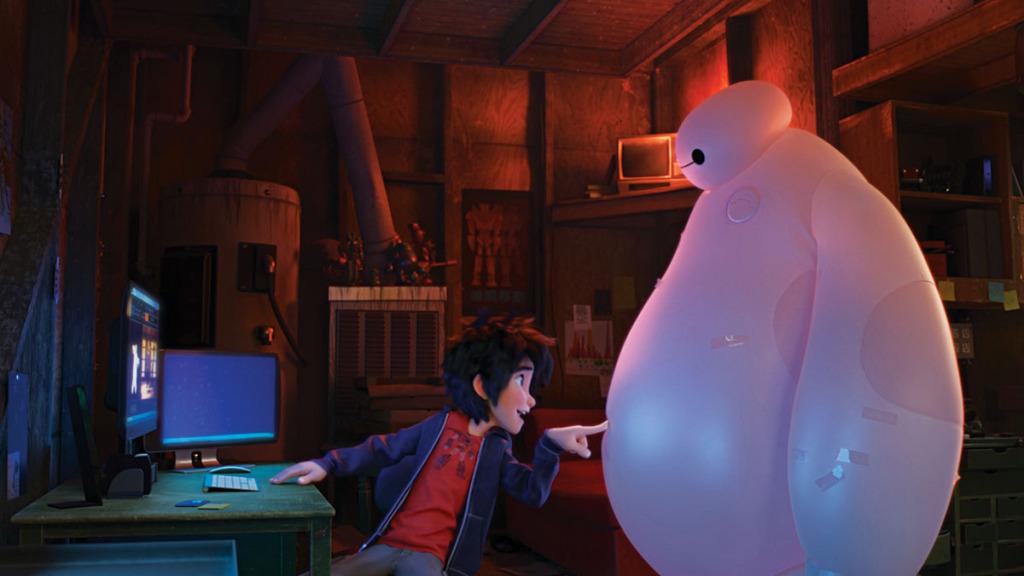It’s a bright and busy day in the fictional city of San Fransokyo, where science fiction and imaginative technology have almost become a way of life. The young protagonist and genius roboticist Hiro Hamada (Ryan Potter) scrambles madly through the bustling streets, chasing after his inflatable health-care robot Baymax (Scott Adsit), who has run away with one of the boy’s machines. The often oblivious, balloon-like Baymax thinks that he is helping to alleviate Hiro’s mental health by figuring out why the machine is acting screwy. Their frantic chase ends at an abandoned warehouse, where they are promptly driven away by a massive swarm of evil miniaturized robots, controlled by a mysterious man in a kabuki mask.
This is a glimpse into Disney’s cutting-edge portrayal of the superhero genre in its latest animated film, “Big Hero 6,” based on the Marvel Comics team of the same name. Following in the footsteps of such spiritual predecessors as “The Avengers” and “Guardians of the Galaxy,” the film’s action-packed premise is assembled by a team of six unlikely heroes: Hiro; Baymax; three college science whizzes, GoGo (Jamie Chung), Honey Lemon (Genesis Rodriguez) and Wasabi (Damon Wayans Jr.); and the comic-book enthusiast Fred (T.J. Miller). Each character is outfitted with his or her own unique super suit for battle to stop the masked villain’s master plan from coming to fruition.
However, borrowing the well-known “assemble-a-team” plot is as derivative as the film gets, and it’s an infinitesimal flaw in what is otherwise a masterpiece of entertainment. From beginning to end, there is a cheery and spirited atmosphere in San Fransokyo that paints a picture of what everyone dreams advances in technology will bring: a not-too-distant, clean, futuristic world where humans peacefully coexist with science.
With magically remarkable visuals that people have come to love from Disney, the majestic artistry of Japan is superimposed onto the diagonal streets and alleyways of the City by the Bay. Vividly colored sci-fi machines complement the shiny reflective skyscrapers in front of beautiful sunsets, while at the same time rusty robots duke it out in dirty back alleys under the cover of night.
Going beyond the requirement of satisfying its PG-intended audience, the film’s elements touch on the tastes of all ages. Both children and adults will find laughs, from Hiro’s snarky pre-pubescent sense of humor to Fred’s hyper-enthusiasm for monsters and Baymax’s innocent clumsiness. In addition, younger audiences will be bouncing up and down in their seats watching splendidly choreographed fight scenes and superhero gadgets galore. Not since “The Incredibles” has Disney rendered computer-animated action so well that it is comparable to young children’s imaginations when pretend fighting.
Leaning toward an all-ages appeal, though, may have led to the film featuring dark undertones some might not think suitable for young children. At times there are connotations of death, orphanhood, revenge and immorality. Although these undertones are subtle, they do reach a culminating point where Hiro, in frustration, resorts to a dangerous and irrational decision that puts others in harm’s way and would probably have been better off not included in the otherwise friendly film.
Despite this, Baymax is the true highlight that carries “Big Hero 6.” His simple, white vinyl design and suzu bell–inspired face make him a perfect combination of cuddly, lovable and easily distinguishable from other standard robots. His naive interpretation of just wanting to help everyone gives ground to hilarious misunderstandings, such as trying to defibrillate Hiro after hearing, “You gave me a heart attack.” He also serves as a brother-father figure to Hiro during the young boy’s coming of age, solidifying his family-oriented role perfectly. Adsit’s voiceover successfully does what no one would expect, bringing comic relief to a literally emotionless artificial intelligence.
“Big Hero 6” joins Disney’s long legacy of wonderful children’s movies, adding high visual caliber and superb action to humor and adventure. Eastern Japanese and Western American culture are happily brought together to create a beloved team of superheroes that audiences are sure to remember for a long time.




















